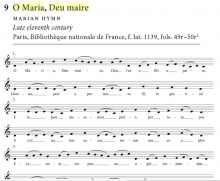Link to performance of "Reis Glorios" by TAE
Link to original source of sheet music for "O Maria, Deu marie" (p. 217) (From Medieval Song in Romance Languages)
It is believed that O Marie, Deu maire, produced at the abbey of Saint Martial, preceded Giraut de Borneil's composition of Reis Glorios. Within this chronology, the contrafactum appropriates the melodic structure of a sacred song for a secular one, while retaining the melodic structure. In the case of these two particular works, Borneil also builds upon the specific iconography of O Maria. The editors of O Maria note that the image of "...a serpent/A resplendent angel..." (lines 3-4) "depicts the serpent as Lucifer (the 'Light-Bringer') in disguise." (p. 18, The cansos and sirventes of the troubadour Giraut de Borneil: a critical edition). The arriva of light underpins de Borneil's alba, where the lover's friend beseeches him, "Sleep no longer, rise up quietly,/for in the east I see the star grown big/that spurs on the day, I knew it clearly, and soon the dawn will rise." (lines 7-10) The dawn, much like the serpent, brings danger, lest the protagonist is not careful. "...do this [wake up], or yours is the harm that will come,/and soon the dawn will rise." (lines 19-20, p. 195, Goldin) The refrain "...and soon the dawn will rise" is the last line of each stanza. In "Parody and Contrafactum: A Terminological Classification," Robert Falck stresses the importance of melody in a work as "contrafactum." "When a melody or whole composition is reused, altered or unaltered, the result is a parody or a contrafactum, depending largely on when it was borrowed." (p. 1, "Parody and Contrafactum: A Terminological Classification") A comparison of one performance of Reis Glorios with the sheet msuic for O Marie, Deu maire reveals a similar melodic structure. Falck reminds us, "Indeed, if the melody remains unchanged, there is no "contra," nothing new to set against the old." (p. 14, Falck) Thus, the similarity of the two raises the question: to what extent did de Borneil practice contrafactum?
Contrafactum in "Reis Glorios" and "O Maria, Deu maire"
Submitted by Lena Emelyn Zlock on Tue, 05/03/2016 - 00:00
Course:
Songs of Love and War: Gender, Crusade, Politics (Sp16-FEMGEN-205-01/FRENCH-205-01)
Project type:

